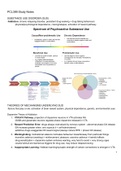Class notes
UofT PCL389 FInal Exam Notes
- Course
- PCL389 (PCL389)
- Institution
- University Of Toronto (U Of T )
Study notes for PCL389 (Pharmacology & Toxicology in Society); covers substance use disorder, theories of addiction, common drugs of abuse, and drug therapies
[Show more]



